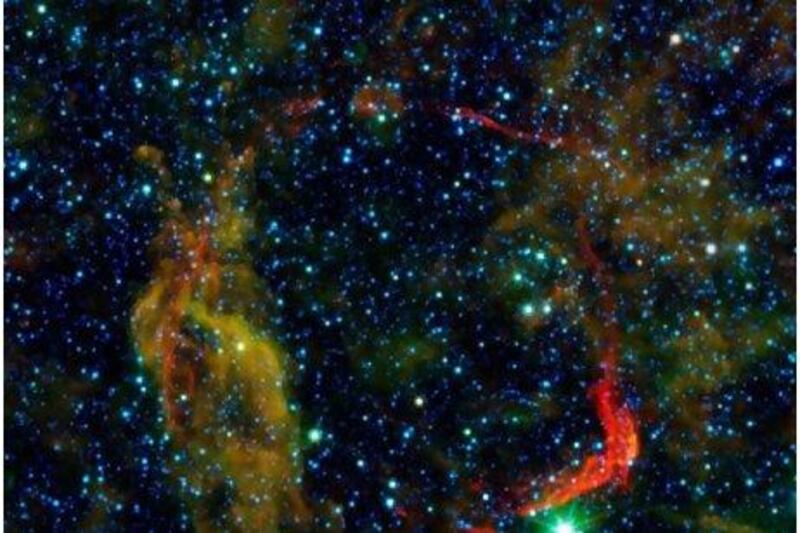For the past few weeks, astronomers have been monitoring events in a galaxy so far away its light took more than 20 million years to reach us.
Their interest was sparked by a supernova explosion so violent that even at such a vast distance it could be seen from Earth with binoculars. As it fades back into obscurity, astronomers are racing to find clues that might explain the driving force of these awesome events.
On the face of it, such research sounds utterly irrelevant to the human condition. Yet paradoxically our connection to supernovas could hardly be more intimate.
Everything around us - including our very skin and bones - is made of atoms created inside these cosmic furnaces.
Not even the Big Bang itself was capable of such a feat: it expanded and cooled too fast to make much beyond atoms of hydrogen and helium. All of the other chemical elements were made in the death throes of massive stars.
Understanding supernovas is thus central to understanding our own origins because we really are quite literally, to coin a hippie phrase, made of stardust.
Reaching that understanding has proved extraordinarily difficult. Despite millennia of observations and more than half a century of intense theoretical effort, exactly what lies behind the violence of supernovas remains a mystery.
They come in various forms but in broad terms all have their roots in a star that gets too big for its own good. Most are the death throes of huge old stars that run out of fuel and collapse, causing an explosive rise in temperature.
Others - such as the event code-named PTF 11kly now being studied - are thought to be the result of one old star cannibalising its companion, gorging itself to the point that it collapses in on itself, triggering an explosion. The resulting violence is bested only by the Big Bang itself.
Many supernovas briefly outshine all the stars in their host galaxies, their cores reaching temperatures in excess of 10 billion°C.
It is under these apocalyptic conditions that the supernovas forge their gift to the universe, in the form of the chemical elements such as carbon, oxygen and nitrogen that make up everything around us, including ourselves.
The nuclear reactions needed to pull off this cosmic conjuring trick have been known for decades and are pretty well understood. So is the initial collapse. Put simply, as a star runs out of fuel or gains too much mass, the force of gravity makes it implode under its own weight.
What baffles astronomers is exactly how the sudden collapse can turn into so violent an explosion.
Part of the answer lies in the fact that while massive, the stars that go into supernova are not hefty enough to collapse forever to become black holes.
As they collapse and their internal temperature and density soar, sub-atomic forces in their cores kick in, abruptly stopping the collapse.
The shuddering stop releases a shock wave that tears up through the overlaying material, gathering up all the newly created atoms and spewing them into space.
Or at least, that is what the shock wave should do. But as it races back up through the star, it must push through huge amounts of matter still plunging inward, slowing it down.
And the problem is that calculations and supercomputer simulations show the shock wave lacks the energy needed to break out of the star. It stalls just a few hundred kilometres beneath the surface.
Clearly, something is missing - some extra source of energy capable of tearing the star apart.
Part of the answer is thought to lie with ghostly particles called neutrinos (the same particles currently at the centre of the faster-than-light controversy).
Observations of supernovas have detected these pouring out of wreckage, having helped to boost the energy of the shock wave. Yet they don't seem quite up to the job.
Now a team of researchers from the UK and Europe is claiming that events inside a supernova might have more in common with the Big Bang than merely mind-boggling temperatures. They suggest the explosions may also involve a form of energy thought to have triggered the birth of the cosmos itself.
Known as a scalar field, it has become the go-to explanation for some of the most dramatic events in the universe.
Part of its magic comes from a bizarre effect predicted by Einstein's theory of gravity, known as General Relativity. This shows that contrary to Newton's old theory, gravity is not generated solely by mass. It can also come from pressure: anything that is crushed generates extra gravitational pull.
But the flip-side is also true: anything being stretched, putting it under tension, will generate an anti-gravitational effect. And as scalar fields can possess tension, they can combat the force of gravity.
Cosmologists have invoked scalar fields for explaining how the universe exploded in a Big Bang, and why it continues to expand at an ever-faster rate.
Now Dr Charles Wang of the University of Aberdeen and his colleagues think scalar fields may give supernovas the final push they need.
The details, published in the current issue of Physics Letters B, are complex, but in essence they suggest the collapse of the star creates waves of scalar fields, which pass through the star and turbocharge the stalling shock wave. Given extra oomph, it bursts out of the star, tearing it apart.
The claim that supernovas are akin to mini Big Bangs is certainly intriguing. Whether it can be substantiated remains to be seen.
But if past experience in cutting-edge science is any guide, we may soon see further evidence that, as the eminent British scientist JBS Haldane put it in 1927: "The universe is not only queerer than we suppose, but queerer than we can suppose".
Robert Matthews is visiting reader in science at Aston University, Birmingham, England






